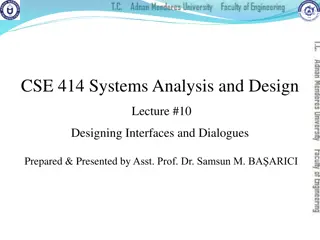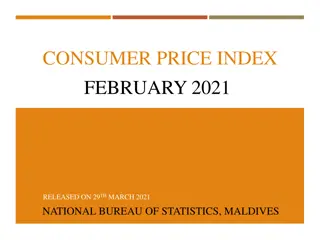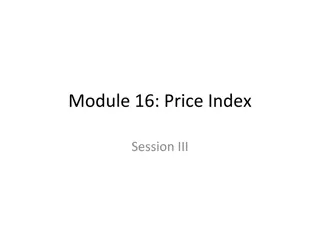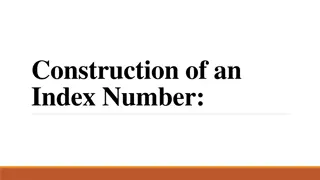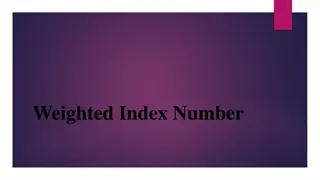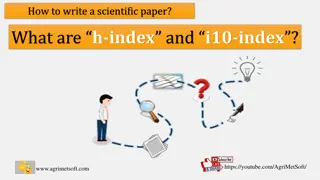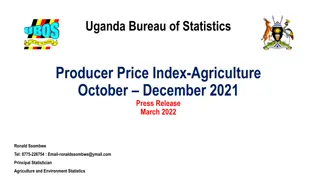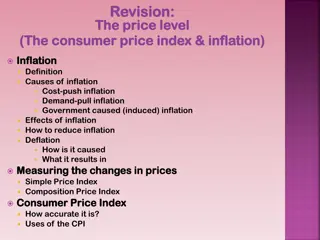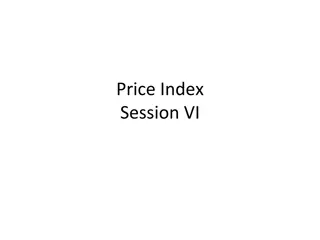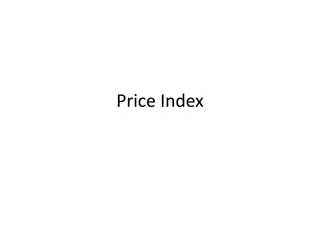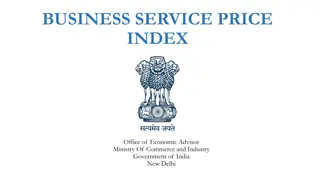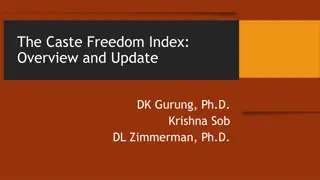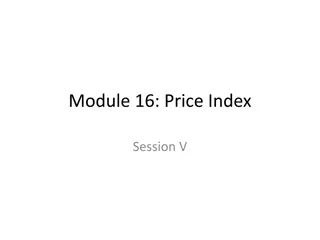Price Index Session VII - Designing Price Data Collection System
This session delves into the process of designing a price data collection system, focusing on product specification, setting norms for item substitution, outlet selection, determining frequency and timing, method of data collection, treatment of seasonal products, quality adjustment, and dealing with missing data. The session provides insights on how to effectively collect and analyze price data for accurate price index calculations.
Download Presentation

Please find below an Image/Link to download the presentation.
The content on the website is provided AS IS for your information and personal use only. It may not be sold, licensed, or shared on other websites without obtaining consent from the author.If you encounter any issues during the download, it is possible that the publisher has removed the file from their server.
You are allowed to download the files provided on this website for personal or commercial use, subject to the condition that they are used lawfully. All files are the property of their respective owners.
The content on the website is provided AS IS for your information and personal use only. It may not be sold, licensed, or shared on other websites without obtaining consent from the author.
E N D
Presentation Transcript
Module 16: Price Index Session VII
Contents Session VII Product and outlet selection Product specification Initial choice Organising data collection Method of collection Frequency and timing Dealing with missing price data Seasonal products Product substitution & quality adjustment 2
Price Data Collection Designing Price Data Collection Designing a price data collection system involves: Product specification & setting norms of Items substitution Outlet selection Determining Frequency and timing Method of data collection centrally or locally Treatment of seasonal products Quality adjustment of products in market Dealing missing data editing & imputation All these, except the last, are discussed in this session.
Product and Outlet Selection Product and Outlet Selection Price data collection requires selection of products and outlets. For each sub-class, the representative items are selected, judging by their relative shares of expenditure or output in the respective sub-class. Once the products are selected, a sample of outlets is selected for price collection of the selected products. Random sampling techniques is recommended to be used for item and outlet selection. But, in most countries, outlets as well as items are selected purposively.
Product and Outlet Selection Product Selection for CPI The items for a sub-class (elementary aggregate) are selected either by the Central/ regional statistical office, using expenditure or market share data where possible, or the most popular varieties are chosen by price collectors, based either on the advice of retailers or on the amount of shelf-space taken up. The selection is done in such a way that the average price movement of the selected varieties represent the price of the sub-class.
Product and Outlet Selection Outlet Selection - CPI Mostly, in developing countries, outlets are selected purposively. Sales data, if available, ought to be used for this purpose. But, mostly, local expertise are used to select the most representative outlets. The central statistical office decides the quotas for major outlet types, such as local markets, shops and departmental stores. The HES may be designed to provide data on the share of major outlet types from where the households purchase a product. The quota for different major outlet types, in that case, can be decided on the basis of HES data.
Product and Outlet Selection Product and Outlet Selection for Output-PPI (1) For PPI compilation, prices are collected for products from establishments (outlets) in particular industries. CPC is the product classification used for this purpose. Though CPC is linked to the ISIC, CPC cannot be used to uniquely identify the industry of a product s origin. The industries to be covered for a product is determined using data on originating activity collected in the business surveys providing source data for weights calculation.
Product and Outlet Selection Product and Outlet Selection for Output-PPI (2) Once the industries to be covered are decided, the establishments within these industries are selected and then the individual (representative) products are selected. Finally, individual transactions that represent the sampled products in each sample establishment are selected.
Product and Outlet Selection Product and Outlet Selection for Output-PPI (3) Representative sampling requires two separate comprehensive and up-to-date sampling frames.: listing the universe of establishments and listing the universe of products. But, most countries continue with purposive selection of establishments and products. The central office draws up lists of products that are deemed to be representative of the products within an elementary aggregate.
Price Data Collection Product Specification Product specification (1) The main criteria for selecting the representative varieties and transaction types for pricing are that they: between them, they account for significant proportion of sales, broadly represent other products of their respective sub- groups, and are expected to stay in market / production for a long period. But, it is quite common to find some selected products and transaction types are no longer available and selection of replacements becomes essential.
Price Data Collection Product Specification Product specification (2) The varieties or items for pricing may be selected by head office, with the price collectors being given a detailed specification, or the price collectors may themselves select the varieties. For each item selected for price collection, a detailed descriptions is essential for correct identification by price collectors selection of an appropriate replacement when the initially selected item is no longer available in the market.
Price Data Collection Product Specification Inclusion of essential features in Specification The detailed written description of an item s specification should include price-determining features features required for future identification and features representing quality.
Price Data Collection Product Specification Specification norms In measuring price changes, variations in quality must be avoided. It introduces bias into a price index. Quality includes: the size of package sold the time of day or day of the week of purchase; type of location of outlet and exact specification. All such Item specification norms vary from being tightly (narrow) defined or generally (broad) defined. The set of items selected for pricing often consists of a mix of broadly and narrowly defined specifications.
Price Data Collection Product Specification Implications of narrow specification Implications of narrow item descriptions are as follows: generally more effective for controlling sample representativeness quality differences, reduces the variance of prices and price relatives, thus optimizing the use of some aggregation formulae. But they can result in a smaller achieved sample, because of less flexibility of choosing an appropriate item in a particular shop.
Price Data Collection Product Specification Implications of broad specification Implications of broad item descriptions are as follows: broad item descriptions can increase the size of the achieved sample. But can be more difficult to control for sample representability and thus result in higher variances in prices collected.
Price Data Collection Outlet Selection Outlet selection There are two broad categories of respondents determining the basic method adopted in price data collection. They are the large number of local shops, retailers and small producers, central offices of large enterprises and the government from whom the price data are collected. For example, a. fuel price of oil companies available at their central offices. b. the administered prices like those charged for public utilities, central or local government fees are revised and notified periodically.
Price Data Collection Outlet Selection Outlet of two kinds (1) There are two basic price collection methods: local and central. Local collection used for most items; prices are obtained from outlets spread over the country. from each outlet, a number of price quotations are obtained normally by visiting the outlet, [prices for some items may be collected by telephone]
Price Data Collection Outlet Selection Outlet of two kinds (2) Central collection used for items where all the prices can be collected centrally with no field work. These prices can be further sub-divided into two categories, depending on their subsequent use: central shops, where the prices are combined with prices obtained locally; and central items, where the prices are used on their own to construct centrally calculated indices.
Price Data Collection Outlet Selection Allocation scheme The number of quotations allocated to a selected rural or urban location of a region is further allocated to the representative varieties (with given item specifications) constituting the elementary aggregate and the major outlet types where they are available.
Price Data Collection Outlet Selection Example 22: Price Collection Plan for an Elementary Aggregate of CPI 100 price quotations are allocated to different varieties. The allocated numbers are then assigned to major outlets types.
Price Data Collection Method of Collection Data collection methods For CPI, a number of different price data collection are used, such as i. personal visit to outlet, recording prices on paper or electronically; ii. by post in paper forms or by e-mail iii. telephone call to outlet; iv. prices observed in catalogues/brochures; v. official price changes notified or announced in the press by government departments or companies with very large market shares. For PPI, data are collected mostly by the methods (ii) to (v).
Price Data Collection Method of Collection Data collection by personal visit Mostly widely used method for CPI data collection is personal visit to the outlets, where descriptions and prices are recorded on paper collection forms, or electronically using hand-held computers. Price collectors are usually regular well-trained staff of a government department. Collectors are required to apply their judgement for identification of correct varieties to be priced substitution of a no-longer-available item with a similar item, detection of seasonal products, noting down additional features of items for future use, etc.
Price Data Collection Frequency & Timing Frequency and Timing The frequency and timing of price collection is primarily determined by the frequency of the index. The desired frequency of price collection varies over commodities It depends on how frequently the prices to be observed change. [For example, for administered prices like those charged by public utilities, central or local government fees revised following a time schedule, or rental of hired residences etc. quarterly or annual collection may be adequate. In contrast, food prices which change charge on a continuous basis are collected more frequently. ]
Price Data Collection Frequency & Timing Time schedule of price data collection Price data collection of different product is scheduled with varying spread and frequency. Higher the frequency lower is the spread. For perishable food items, it is usually spread over a week and for other food items it is spread over month. Different neighbourhoods is scheduled for price collection at different times of the week / month. Individual price observations are carried out at the same day of each week / month. Price collection days (and time) are set in advance.
Price Data Collection Frequency & Timing Factors determining frequency and timing (1) Uses of the index: If used for deflating income, expenditure or sales, the index should relate to the period of time. Practicalities of carrying out price collections: In practice, the observations are either spread over a few days for a point-in-time estimate or the whole month for the average for that month.
Price Data Collection Frequency & Timing Factors determining frequency and timing (2) Pattern of price movements: The desired frequency depends on how frequently the prices to be observed change. For example, the official/ administered/ catalogue prices change annually or quarterly according to a known timetable collected annually or quarterly food prices are charged by their suppliers on a continuous basis. collected more frequently. and therefore these price collections can be carried out rather than every month. Timing of index publication: The timing of the publication of indices also determines the time schedule of price collection.
Dealing with Missing Price Missing Price Data when? Price data of an item become missing mainly under three distinct circumstances: permanently discontinued, not be available in same specification quality change, it is a seasonal item.
Dealing with Missing Price Missing Price Data - Types Permanently missing Product withdrawn for good Quality change of comparable nature non-comparable nature Temporarily missing Seasonal product Non-seasonal product expected to be available in the future.
Dealing with Missing Price Dealing with Missing Price (1) Commonly used approaches adopted for dealing with missing items: Seasonal product: Price collectors are required to record prices only when it is available. Permanently missing product: The item is dropped, without collecting any additional information. Implicit assumption: price change of other items of the group reflects price change of the missing item
Dealing with Missing Price Dealing with Missing Price (2) Permanently missing product: Replaced with an Item of comparable quality. The price collector records information on price-determining characteristics of the new item. The price relative is computed as the ratio between current- period price of replacement item and the previous-period price of missing item. Underlying assumption: replacement item is comparable in quality to the missing item.
Dealing with Missing Price Dealing with Missing Price (3) Permanently missing product: Replaced with an Item of non-comparable quality. The price collector records information on price-determining characteristics and collects price of the new item in the previous period. The price relative for the new product is computed using the overlap period-price. Underlying assumption: prices of the both the items available in the overlap period is an estimate of quality difference.
Price Data Collection Product substitution Pricing products not in market A major problem for both local and central price collections. Price collectors are required to: ascertain that the item is no longer in the market Find an appropriate substitute. For replacement, the price collector should normally take the nearest equivalent product available in the outlet. Nearest equivalent product: The one which has similar characteristics which determine price and purchasing habits is expected to be available in the market for some time to come.
Price Data Collection Product substitution Items substitution When a price collector finds that a variety is no longer available in the market, a replacement with a similar product is made. This requires recording the detailed description of the new variety and making quality adjustments made if necessary, based on differences in characteristics of the replaced and replacement .
Price Data Collection Product substitution Replacing a product While proposing replacement, the price collector should provide a detailed specification of the new item - for identification of quality change, if any. Desirably, the nominal price of the product proposed as a replacement in previous period should also be collected. This can normally be collected from the outlet itself.
Price Data Collection Product substitution Overlap Method: The measurement of price change is switched from the old item to the new one. There is a period (March) of overlap, price relatives (with January as the base) are calculated as the price relatives of the old product A till March. Henceforth it is calculated as the price relatives (PR) of the new product B, as follows: PR of April = (PR of A in March) *(PR of B in Apr. with March as base) Example 23: Overlap method price in Item Jan. Feb. Mar. Apr. May old specification A 200 210 204 new specification B 153 162 159 Calculate these values in your workbook Price relative 100 105 102 108 106
Price Data Collection Seasonal Product Pricing seasonal products The supplies and prices most of the food items and some clothing items vary seasonally. At the designing stage of a price index, the designers keep provision for appropriate adjustments for seasonality. Collectors are required to follow special rules for collecting prices of seasonal items.
Price Data Collection Seasonal Product Seasonality two kinds Strongly seasonal commodity:A product that is not available in the marketplace during certain seasons of the year. Weakly seasonal commodity: A product that is available throughout the year but there are regular fluctuations in prices or quantities that are synchronized with the season or the time of the year.
Price Data Collection Seasonal Product Seasonality two kinds Strongly seasonal commodity:A product that is not available in the marketplace during certain seasons of the year. Weakly seasonal commodity: A product that is available throughout the year but there are regular fluctuations in prices or quantities that are synchronized with the season or the time of the year.
Price Data Collection Seasonal Product Strong Seasonality the Problem The strongly seasonal products create the biggest problems in producing a monthly or quarterly Price Index. If a product price is available for only one of the two periods being compared, it is not possible to calculate its price relatives. [Treatment of seasonal products in compilation of price indices is discussed in some detail in the next session.]
Price Data Collection Quality Change Quality Change Substitutions made by a new good or service for quality change are mainly of two kinds: An evolutionary new good or service is one that meets existing needs in much more efficient, or new, ways. In practice, an evolutionary new good can be fitted into some subclass of the product or industry classification. A revolutionary new good or service provides completely new kinds of services or benefits. Its inclusion requires some modification to the classification in order to accommodate it.
Price Data Collection Quality Change Quality Adjustment Both the kinds of substitution usually require adjustments in prices due to change in quality. In practice, quality adjustments are done with the help of: very experienced price collectors or data analysts, knowledgeable retailers producers, to estimate the effect of quality change on price, or the marginal cost of the new features, expert panels for valuation of any quality change. Hedonic regression models.




